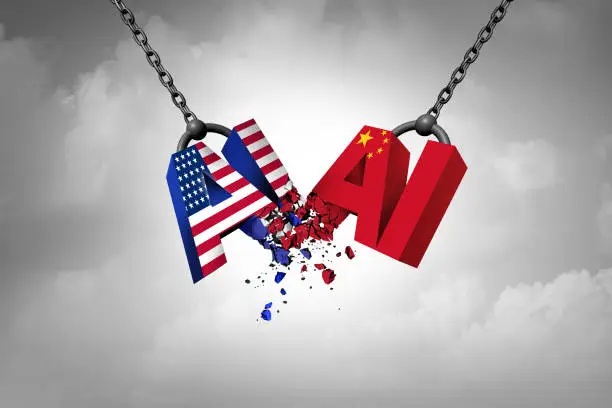As artificial intelligence transforms economies and geopolitics, the United States and China are locked in a fierce race for dominance. From innovation and investment to regulation and ideology, their contest over AI is shaping the balance of global power in the 21st century.

By Newswriters Editorial Desk
Artificial Intelligence (AI) has become the defining technology of our era — a force that will determine not only which nations lead the global economy but also who sets the moral and political rules of the digital world. Today, the United States and China are the two principal players in this high-stakes race, investing billions to secure supremacy in AI research, development, and application. Their competition is not merely technological; it is ideological and strategic — shaping the future of innovation, security, and governance.
AI Innovation Showdown: U.S. vs China in the Talent and Tech Race
The United States entered the AI race with a formidable head start, powered by Silicon Valley’s innovation culture, elite universities, and technology giants such as Google, Microsoft, and OpenAI. American firms dominate the creation of foundation models, large language models (LLMs), and advanced AI applications. OpenAI’s ChatGPT and Anthropic’s Claude exemplify the U.S. lead in generative AI, supported by massive investments and open collaboration between academia and industry.
China, however, has quickly closed the gap. Backed by a state-led vision, Beijing’s “Next Generation Artificial Intelligence Development Plan” aims to make China the global leader in AI by 2030. Tech titans like Baidu, Alibaba, Tencent, and Huawei are pouring resources into machine learning, computer vision, and AI chips. China already leads in AI patents, facial recognition, and large-scale data utilization — driven by its vast population and relatively loose data regulations.
Tech Wars: How AI is Shaping Global Security and Strategy
AI supremacy is now a matter of national security. The United States views China’s rapid progress as a strategic threat, particularly in military applications, surveillance technologies, and cyber warfare. Washington has responded by tightening export controls on semiconductors and advanced chips, restricting Chinese access to high-end computing power crucial for training large AI models.
Beijing, on the other hand, sees AI as the key to breaking Western technological dependence and asserting leadership in global governance. The competition extends to international institutions, where both nations push for their ethical and regulatory visions to define global AI norms. While the U.S. advocates for open, market-driven innovation, China promotes state-guided AI development aligned with its political priorities.
Balancing Innovation and Ethics in the U.S.–China AI Race
AI could contribute trillions of dollars to the global economy, reshaping industries from healthcare to defense. But with economic opportunity comes ethical uncertainty. Both the U.S. and China are grappling with how to regulate AI without stifling innovation. The U.S. emphasizes “responsible AI” and democratic oversight, while China integrates AI governance into its system of social control and censorship.
Conclusion: The Stakes of AI Supremacy
This technological rivalry between the United States and China is not just about algorithms or market share — it is about who will define the values, rules, and architecture of the digital future. As AI transforms everything from defense systems to education, healthcare, and media, the stakes extend far beyond economics. The contest is reshaping alliances, trade networks, and governance models, forcing other nations to align with one of two emerging visions: America’s open, innovation-driven model or China’s state-directed, data-rich system.
The outcome will determine not only which superpower dominates global markets but also whose ethical framework guides humanity’s relationship with intelligent machines. In this century, power will belong to those who can harness intelligence — both artificial and human — most effectively. The race for AI supremacy, therefore, is not merely a competition for technological leadership; it is a struggle for control over the future itself.
Sources:
- The White House (2023). National Artificial Intelligence Research and Development Strategic Plan. https://www.whitehouse.gov/ostp/
- State Council of the People’s Republic of China (2017). New Generation Artificial Intelligence Development Plan. http://www.gov.cn/zhengce/content/2017-07/20/content_5211996.htm
- McKinsey Global Institute (2023). The Economic Potential of Generative AI: The Next Productivity Frontier. https://www.mckinsey.com/
- Center for Strategic and International Studies (CSIS, 2023). AI, Chips, and the Geopolitics of Innovation. https://www.csis.org/
- The Economist (2024). America vs China: The Battle for AI Supremacy. https://www.economist.com/
- Kai-Fu Lee (2018, updated 2023). AI Superpowers: China, Silicon Valley, and the New World Order. HarperCollins.



